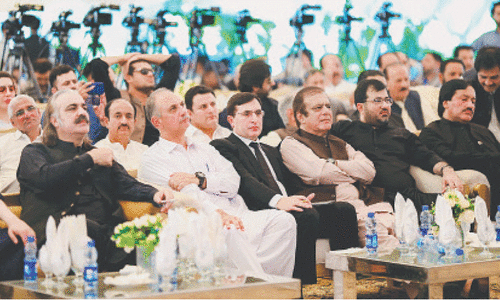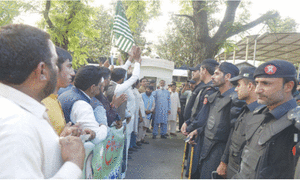Initial report finds human error on part of pilots, ATC officials in PIA crash: aviation minister

Aviation Minister Ghulam Sarwar Khan, while speaking in the National Assembly on Wednesday, said that the initial report of the Pakistan International Airlines (PIA) May 22 plane crash found the pilots and air traffic control (ATC) officials to be at fault for not following set procedures.
Khan said that both the pilots and the ATC ignored "standard protocols".
The PIA Airbus A320 crashed last month in Karachi's Model Colony, close to the Jinnah International Airport, killing all but two of the 99 aboard. Flight PK-8303 from Lahore came down about a kilometre short of the runway on its second attempt to land.
Preliminary findings
While detailing the possible circumstances that culminated in the air crash, the preliminary investigation report states that the safety investigation was not meant to "apportion blame or liability".
"Accordingly, it is inappropriate to use AAIB [interim] investigation report to assign fault or blame or determine liability," it adds.
The preliminary report, seen by Dawn.com, found that:
- The departure from Lahore and cruising flight of PK-8303 were uneventful. However, "The crew did not follow standard callouts and did not observe CRM ( Crew Resource Management) aspects during most parts of flight."
- On its first approach, the aircraft was cleared to descend to 3,000 feet by the time it reached Makli. However, "the aircraft ended up higher than the required descend profile" and was at 9,780 feet and a speed of about 245 knots at Makli.
- In order to manage the descent and lose the additional height, “OPEN DES” mode was selected via the Fuel Control Unit, both autopilots were disengaged and speed brakes were extended.
- The 'Karachi Approach' tower, also called the air traffic control, advised the pilot to do an orbit so that the aircraft could be adjusted on the required descend profile. However, no orbit was executed and the landing approach was continued.
- The landing gears were lowered at an altitude of 7,221 feet at around 10.5 nautical miles from runway 25L, according to flight data.
- Karachi Approach advised the pilot "repeatedly" about the plane's excessive height but the landing approach was not discontinued. Instead, in a move termed by the aviation minister as "inexplicable", the plane's landing gears were raised and speed brakes were retracted when it was at a height of 1,740 feet and at a distance slightly less than five nautical miles from the runway. The plane then gave over-speed and ground proximity warnings.
- Since the landing approach was continued, Karachi Approach instead of changing over the aircraft to 'Aerodrome Control' sought telephonic landing clearance from the Aerodrome Control, which conveyed a landing clearance for the aircraft "without observing the abnormality that the landing gears were not extended" to Karachi Approach. Subsequently, Karachi Approach cleared the aircraft to land.
- According to the FDR and CVR recordings, "several warnings and alerts such as over-speed, landing gear not down and ground proximity alerts were disregarded" by the pilots. The landing was carried out with the landing gears retracted, leading to the aircraft engines scrubbing the runway surface at various points and suffering damage. Security footage showed sparks caused by the aircraft engines touching the runway while the scrubbing marks were also pictured on the runway.
- The Aerodrome Control observed the scrubbing of engines with the runway but did not covey this abnormality to the aircraft. It was conveyed to the Karachi Approach via telephone, however, Karachi Approach did not relay this information to the aircraft.
- The aircraft then discontinued landing and performed a go-around. At this point, data shows the landing gear lever was briefly switched to 'down' position, but it was immediately followed by its movement to 'up' position.
- The pilot then conveyed his intention to make another landing approach on runway 25L, however, shortly after the go-around, both engines failed one by one. FDR data recording stopped at this point due to a design limitation.
- With the aircraft unable to maintain the required height, the aircrew transmitted a Mayday call saying they had lost both the engines. The plane subsequently crashed about 1,340 metres short of the runway. It was a "slow-speed impact with [a] high angle of attack", with the landing gears extended.
- Evidence from the wreckage indicates reasons for the failure of the right engine, however, the left engine requires further examination. Additionally, the landing gear in extended position "did not demonstrate any malfunction of the landing gear system".
- The aircraft was "reportedly serviceable" for the flight; necessary scrutiny of the aircraft maintenance records is underway. The captain and first officer were "adequately qualified and experienced" to undertake the said flight.
'Overconfidence and lack of focus'
According to Khan, there was no technical fault in the plane and both the pilots were medically fit to fly. He added that data from the Digital Flight Data Recorder (DFDR) and Cockpit Voice Recorder (CVR) was decoded in the presence of foreign experts.
"According to the report, the plane was 100 per cent fit for flying. It had no technical fault. Flights were suspended due to corona, the plane took its first flight on May 7 and the crash happened on May 22. In between, it completed six flights successfully; five to and from Karachi and one to Sharjah.
"The pilot on the final approach did not identify any technical fault [as well]. At a distance of 10 miles from runway, the plane should have been at an altitude of 2,500 feet but it was around 7,220 feet. This was the first irregularity," Khan said.
He said that the ATC told the pilot thrice that the plane was too high to land but he refused to listen. Another important factor was that the pilot closed the landing gears at a distance of five nautical miles from the runway even though they were open before, he added.
Talking about further mistakes, Khan said that the plane was on auto-landing but the pilot brought it back to manual landing before the crash. It should have come in at 40 degrees but it dived at 60 degrees, he added.
The minister also blamed the pilots' "overconfidence and lack of focus" for the crash. "The pilots were discussing corona throughout the flight. They were not focused. They talked about corona [...] their families were affected. When the control tower asked him to decrease the plane's height, the pilot said 'I'll manage'. There was overconfidence."
The preliminary report, a copy of which is available with Dawn.com, makes no mention of the pilots’ conversation or even that they were distracted as stated by the minister in the National Assembly.
The minister, however, added that the control tower was at fault too for not pointing out the damage to the plane after a failed attempt at landing. "[Air traffic controller] should have informed when he saw the engines on fire. The control tower did not inform pilot [so it] was at fault too. When the plane took off again, both engines were damaged.
"He was an extremely experienced pilot. What is sad is that because of the overconfidence and lack of focus of pilot and co-pilot, such a big incident happened. The interim report says cabin crew and control tower were also at fault," he said, adding that the full report would be released before the end of the year.
The minister also spoke about past accidents, the Air Blue crash in 2010, Bojha Airlines crash in 2012, plane crash in Chitral in 2016 and the crash landing of a plane in Gilgit in 2019. He said that Air Blue and Bojha Airlines crash occurred due to "human error and various breaches of flying discipline".
He added that the technical fault in the Chitral incident was "so complicated" that the plane manufacturer itself has not been able to reach a conclusion yet. The minister, however, promised that its inquiry report would be presented in August of this year.
'Almost 40pc pilots have fake licenses'
The minister said that the government had observed that major airlines in other countries did not have such a history of crashes and therefore, started to investigate pilots. There are 860 active pilots in the country, he said, adding that of these 860, 262 pilots did not even take their exams themselves.
Decrying that pilots were not hired on merit, Khan said that fake degrees and licenses were issued. "Almost 40 per cent of pilots have fake licenses," he said, adding that they did not have flying experience either.
He added that the government had started to take action against all such pilots. "In the first phase, 54 such pilots were identified. Show cause notices were issued to 24 and nine others confessed that they were unqualified.
"I believe this issue should not be politicised. It is a matter of national security. The inquiry has been free, fair and transparent," he concluded.
Shortly after the crash last month, the government had formed a committee, headed by Air Commodore Usman Ghani, who is president of the Aircraft Accident Investigation Board to determine the causes of the crash and issue a report in one month's time.
An 11-member team of Airbus, the manufacturer of the A320 aircraft, had also visited the country and investigated the site of the incident to offer technical assistance to Pakistani investigators in the PK-8303 crash probe.
Earlier this month, the Civil Aviation Authority (CAA) said in a letter to the PIA that the pilot of the crashed aircraft did not follow the instructions of the ATC.
The CAA letter said the duty approach controller had raised a non-compliance report in respect of the pilot of PK-8303. It claimed that the pilot was warned twice about his speed and high altitude for approach but he did not follow.















































